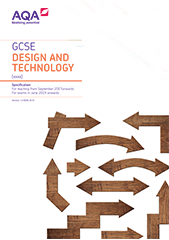The subject content and assessment criteria for GCSE Design and Technology will change from 2017 onwards. The changes will mean that there will be no endorsed routes with this qualification—there will be a single title of GCSE Design and Technology. Students will study a broader range of materials, but choose an area of interest to study in more depth.
Examples of materials to be studied in more depth include:
-
GRAPHICS - papers and boards
-
RESISTANT MATERIALS - Natural and manufactured timber, Ferrous and non-ferrous metals, Thermoforming and thermosetting polymers
-
TEXTILES - Natural, synthetic, blended and mixed fibres, and woven, non-woven and knitted textiles
Students will acquire subject knowledge in Design and Technology that builds on key stage 3, incorporating knowledge and understanding of different materials and manufacturing processes in order to design and make, with confidence, prototypes in response to issues, needs, problems and opportunities. Students will learn how to take design risks, helping them to become resourceful, innovative and enterprising citizens. They will develop an awareness of practices from the creative, engineering and manufacturing industries. Through the critique of the outcomes of design and technology activity, both historic and present day, students will develop an understanding of its impact on daily life and the wider world and understand that high-quality design and technology is important to the creativity, culture, sustainability, wealth and well-being of the nation and the global community.
|
Course Title:
|
GCSE Design and Technology |

View Specification
|
|
Exam Board:
|
AQA
|
|
Course Code:
|
8552
|
|
QAN:
|
603/0984/2 |
Assessment Criteria
The new GCSEs in Design and Technology will not be tiered. 50% of total marks will be allocated to exams, and 50% to non-exam assessment in the form of a Design and Make coursework project.
Coursework (50%)
Students are required to produce at least one final made prototype based on a design brief they develop in response to a contextual challenge set by the exam board. When completing their project students will apply designing and making principles and their knowledge and understanding of technical principles. Specifications should provide a range of broad and contemporary contextual challenges, which provide a basis from which students can undertake a design, make and evaluate project. Students may ONLY choose one option choice in Design and Technology and MUST indicate which material choice they wish to study in depth from.
Where next?
The study of design and technology seeks to prepare students to participate confidently and successfully in an increasingly technological world; and be aware of, and learn from, wider influences on design and technology, including historical, social/cultural, environmental and economic factors. GCSE design and technology specifications enables students to work creatively when designing and making and apply technical and practical expertise.
If you have any questions or queries relating to the Technology curriculum please email headoftech@ecclesbourne.derbyshire.sch.uk for more information.